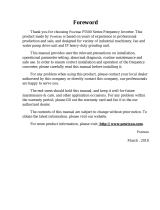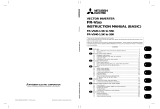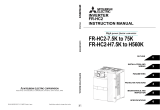
Safety instructions 1
Thank you for choosing this Mitsubishi Electric multifunction regeneration converter.
This Instruction Manual provides handling information and precautions for use of the this product. Incorrect handling might cause
an unexpected fault. Before using this product, always read this Instruction Manual carefully to ensure proper use of this product.
Please forward this Instruction Manual to the end user.
Electric shock prevention
Fire prevention
Injury prevention
Additional instructions
The following instructions must be also followed. If the product
is handled incorrectly, it may cause an unexpected fault, injury,
or electric shock.
Safety instructions
Do not attempt to install, operate, maintain or inspect the
product until you have read through this Instruction Manual
and supplementary documents carefully to use the equipment
correctly. Do not use this product until you have a full
knowledge of the equipment, safety information and
instructions.
Installation, operation, maintenance and inspection must be
performed by qualified personnel. Here, qualified personnel
means a person who meets all the following conditions.
• A person who possesses a certification in regard with
electric appliance handling, or person took a proper
engineering training. Such training may be available at your
local Mitsubishi Electric office. Contact your local sales office
for schedules and locations.
• A person who can access operating manuals for the
protective devices (for example, light curtain) connected to
the safety control system, or a person who has read these
manuals thoroughly and familiarized themselves with the
protective devices.
In this Instruction Manual, the safety instruction levels are
classified into "WARNING" and "CAUTION".
Incorrect handling may cause hazardous
conditions, resulting in death or severe
injury.
Incorrect handling may cause hazardous
conditions, resulting in medium or slight
injury, or may cause only material
damage.
Note that even the level may lead to a
serious consequence depending on conditions. Be sure to
follow the instructions of both levels as they are critical to
personnel safety.
Do not remove the front cover or the wiring cover while the power
of this product is ON. Do not operate this product with any cover
or wiring cover removed, as accidental contact with exposed
high-voltage terminals and internal components may occur,
resulting in an electrical shock.
Even if power is OFF, do not remove the front cover except for
wiring or periodic inspection as you may accidentally touch the
charged circuits and get an electric shock.
Before wiring or inspection, check that the LED display of the
operation panel is OFF. Any person who is involved in wiring or
inspection shall wait for 10 minutes or longer after power OFF,
and check that there are no residual voltage using a tester or the
like. The capacitor is charged with high voltage for some time
after power OFF, and it is dangerous.
This product must be earthed (grounded). Earthing (grounding)
must conform to the requirements of national and local safety
regulations and electrical code (NEC section 250, IEC 61140
class 1 and other applicable standards). A neutral-point earthed
(grounded) power supply must be used for 400 V class
multifunction regeneration converter to be compliant with EN
standard.
Any person who is involved in wiring or inspection of this product
shall be fully competent to do the work.
The product body must be installed before wiring. Otherwise,
electric shock or injury may result.
Do not subject the cables to scratches, excessive stress, heavy
loads or pinching. Doing so may cause an electric shock.
Do not change the cooling fan while power is ON as it is
dangerous.
This product must be installed on a nonflammable wall without
any through holes so that nobody touches the heatsink, etc. on
the rear side of the product. Installing it on or near flammable
material may cause a fire.
If this product has become faulty, the product power must be
switched OFF. A continuous flow of large current may cause a
fire.
Be sure to perform daily and periodic inspections as specified in
the Instruction Manual. If this product is used without any
inspection, a burst, breakage, or a fire may occur.
The voltage applied to each terminal must be as specified in the
Instruction Manual. Otherwise a burst, damage, etc. may occur.
The cables must be connected to the correct terminals.
Otherwise a burst, damage, etc. may occur.
The polarity (+ and -) must be correct. Otherwise a burst,
damage, etc. may occur.
While power is ON or for some time after power-OFF, do not
touch the multifunction regeneration converter as it will be
extremely hot. Touching it may cause a burn.
Transportation and installation
This product must be transported in correct method that
corresponds to the weight. Failure to do so may lead to injuries.
Do not stand or place any heavy object on the product.
Do not stack the boxes containing products higher than the
number recommended.
When carrying this product, do not hold it by the front cover.
Doing so may cause a fall or failure of the product.
The installing orientation of the product must be correct.
Do not install or operate this product if it is damaged or has parts
missing.
Prevent conductive items such as screws and metal fragments, or
flammable substances such as oil from entering this product.
As this product is a precision instrument, do not drop or subject it
to impact.
The surrounding air temperature must be -10 to +50°C∗1 (non-
freezing). Otherwise the product may be damaged.
The ambient humidity must be 95% RH or less (non-condensing).
Otherwise the product may be damaged. (For the details, refer to
page 29.)
The temporary storage temperature (applicable to a short limited
time such as a transportation time) must be between -20 and
+65°C. Otherwise the product may be damaged.
This product must be used indoors (without corrosive gas,
flammable gas, oil mist, dust and dirt etc.) Otherwise the product
may be damaged.
This product must be used at an altitude of 2500 m or less, with
5.9 m/s2 or less vibration at 10 to 55 Hz (directions of X, Y, Z
axes). Otherwise the product may be damaged. (For the
installation at an altitude above 1000 m, consider a 3% reduction
in the rated current per 500 m increase in altitude.)
If halogen-based materials (fluorine, chlorine, bromine, iodine,
etc.), included in fumigants to sterilize or disinfect wooden
packages, infiltrate into this product, the product may be
damaged. Prevent residual fumigant components from being
infiltrated into the product when packaging, or use an alternative
sterilization or disinfection method (heat disinfection, etc.). Note
that sterilization of disinfection of wooden package should be
performed before packing the product.
Test operation
Before starting the operation, confirm or adjust the parameter
settings. Failure to do so may cause some machines to make
unexpected motions.
Before starting the operation, check the wiring of each peripheral
device. Faulty wiring may cause some machines to make
expected motions.
∗1 10 to +40°C (non-freezing) at the +40°C rating.

























